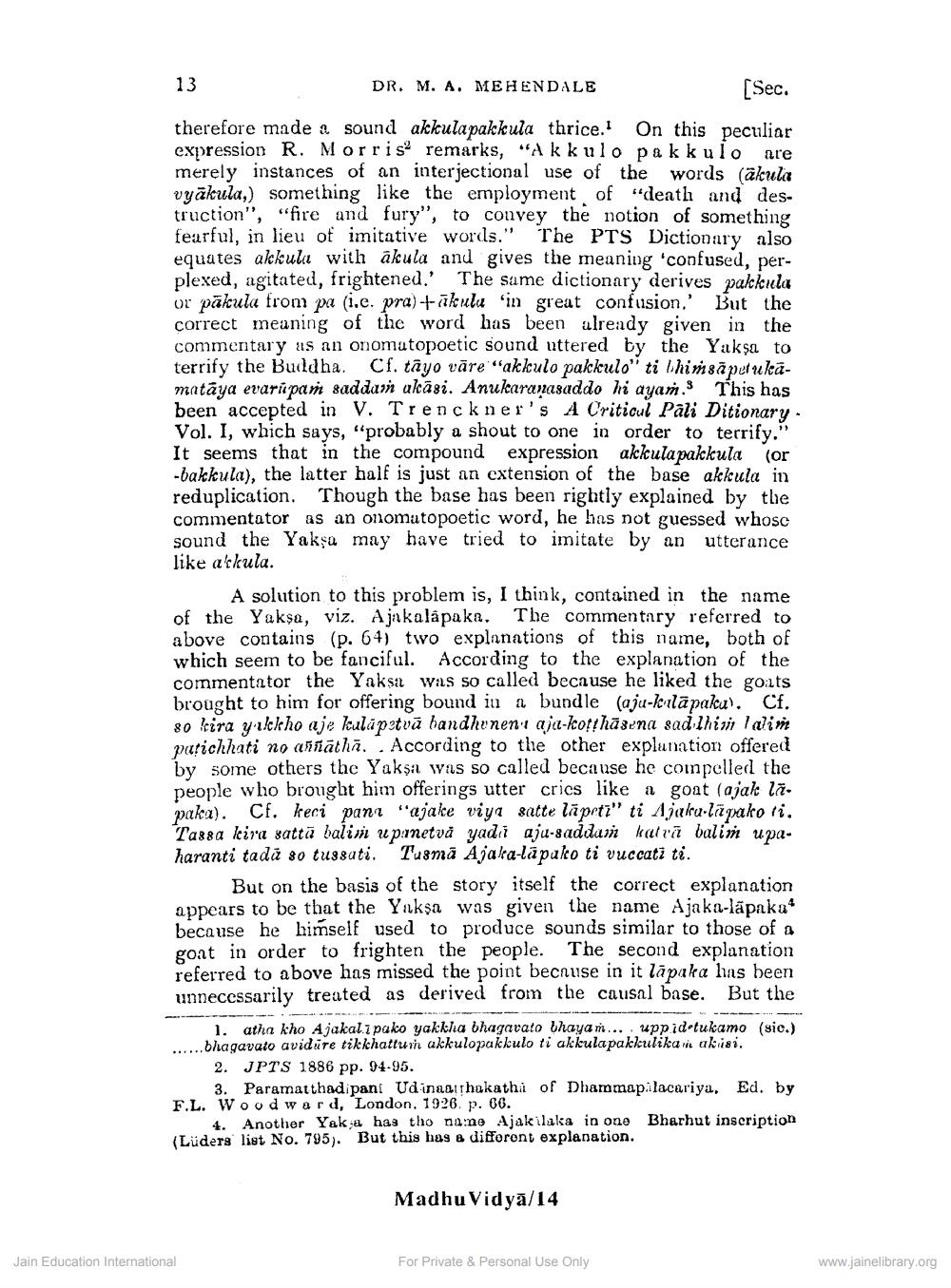________________
13
DR. M. A. MEHENDALE
(Sec.
seems that ther half is just ce has been rights not guessed was
therefore made a sound akkulapakkula thrice. On this peculiar expression R. Morris remarks, "Akkulo pa k k ulo are merely instances of an interjectional use of the words (alcula vyākula,) something like the employment of "death and destruction", "fire and fury", to convey the notion of something fearful, in lieu of imitative words." The PTS Dictionary also equates akkula with akula and gives the meaning 'confused, perplexed, agitated, frightened.' The same dictionary derives pakkula or pakula from pa (i.e. pra)+kula 'in great confusion.' But the correct meaning of the word has been already given in the commentary as an onomatopoetic sound uttered by the Yaksa to terrify the Buddha. Cf. tâyo vāre "akkulo pakkulo' ti bhinsaputukamatāya evarü par saddam ukāsi. Anukaranasaddo hi ayam. This has been accepted in V. Trenckner's A Criticul Pali Ditionary - Vol. I, which says, "probably a shout to one in order to terrify." It seems that in the compound expression akkula pakkula (or -balkula), the latter half is just an extension of the base akkula in reduplication. Though the base has been rightly explained by the commentator as an onomatopoetic word, he has not guessed whoso sound the Yaksa may have tried to imitate by an utterance like akula.
A solution to this problem is, I think, contained in the name of the Yakşa, viz. Ajakalapaka, The commentary referred to above contains (p. 64) two explanations of this name, both of which seem to be fanciful. According to the explanation of the commentator the Yaksa was so called because he liked the gouts brought to him for offering bound in a bundle (aju-kılāpaku). Cf. 80 kira yılck ho aje kulipatvā bandhunen'ı aja-kotthāzuna sad lhin laim parichhati no ansiātha. . According to the other explanation offered by some others the Yakşa was so called because he compelled the people who brought him offerings utter crics like a goat (ajal la. paka). Cf. keci panı "ajake viya satte lāprti" ti Ajalu.lāgako ii. Tassa lira sattā baliji u ponetvå yadii aju-saddam katra balin upaharanti tadū 80 tussuti. T'usmā Ajala-läpako ti vuccati ti.
But on the basis of the story itself the correct explanation appears to be that the Yaksa was given the name Ajaka-lāpaka* because he himself used to produce sounds similar to those of a goat in order to frighten the people. The second explanation referred to above has missed the point because in it läpaka has been unnecessarily treated as derived from the causal base. But the
1. atha kho Ajakal 7 pako yakkha bhagavato bhayan.... uppid-tukamo (sic.) .bhagavato avidure tikkhattur akkulopakkulo ti akkula pakkulika akisi.
2. JPTS 1886 pp. 94-95.
3. Paramatthadi pani Udinacithakathi of Dhammapilacariya, Ed. by F.L. Woodward, London, 1926. p. 66.
4. Another Yaka has tho nano Ajakilala in one Bharhut inscription (Lüders list No. 795). But this has a difforont explanation.
Madhu Vidyā/14
Jain Education International
For Private & Personal Use Only
www.jainelibrary.org




